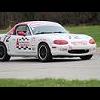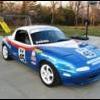Jason, I agree with some of your observations but not all. We have three 1.6 cars, two ‘99s and a VVT. I have owned a dyno much longer than Jim or Dave and although they have certainly tested more different cars we probably have more time and pulls on the same pair of 1.6s than almost anyone starting back around 2004. The only point being that we have put a lot of that time and effort into controlling variables to ensure meaningful results.
You mentioned an apparent lack of sensitivity to both timing and fuel once they are close. We have observed the same thing to some degree, a plateau of sorts about 2 degrees of advance and a few tenths of AFR. That’s not a lot and if tuning to the lean side you don’t want to stray much more in that direction.
But I’m less in agreement with respect to environmental conditions. I’m not sure how closely you monitored raw uncorrected power or the SAE correction factor applied, but large shifts in temperature, humidity and barometric pressure obviously require some changes to maintain ideal tune. The comparatively crude system on these cars attempts to apply some trims but monitoring AFR or Lambda under vastly different conditions shows their limits. The NBs aren’t perfect either but probably better.
The weight and drag issue is a good one and touches on some prior discussions here. You are an engineer so I don’t expect to educate you but some others may appreciate explanations with my assumptions. Correct me where you see it differently.
Similar to a better corner exit speed, more torque very early in a long straight continues to pay dividends even after the sort term acceleration advantage is lost. The earlier you gather speed the longer you get to use it, even if your ultimate trap speed is equal to or even lower than a car with less torque. A good friend likes reminding me of this when I point to trap speeds and tell him to stop whining about low end power.

Towards the other end of the longest straights even seemingly significant power differences (by our standards) are totally overshadowed by aero drag. Any percieved difference in the
rate of acceleration above say 100 mph has little to do with HP assuming well tuned cars and appropriate shift points. At those speeds closing rate was either accumulated earlier (see above) or is the result of reduced drag, whether inherent of from the draft etc. One notable exception to this, and somewhat at odds with your experience, is that the 1.6 has the same gearing but should have about 200 more RPM available before shifting. Many a time after struggling to make ground even with the draft, that extra few seconds in 4th while the car ahead has to upshift and then looses a big chunk of torque to gearing is when the 1.6 can close a bit on the NBs.
Back to differences in aero, I do not recall the claimed CD or frontal area of the NA vs NB, with or without the front lips. You probably have that but by the time we are in 5th gear small differences there become much more important than a couple HP or lb/ft of torque, so I agree that parity could potentially be significantly different at big fast tracks.




 Sign In
Sign In Create Account
Create Account








 Back to top
Back to top Report
Report
















